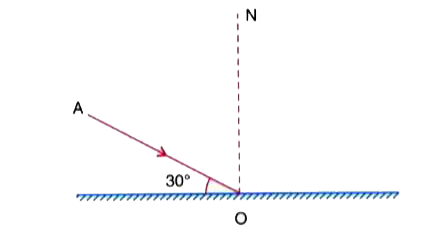When a ray of light falls normally on a plane mirror. The angle of incidence will be
90∘
0∘
45∘
180∘
To solve the question "When a ray of light falls normally on a plane mirror, the angle of incidence will be," we can follow these steps:
1. Understand the Concept of Normal:
- The normal is an imaginary line that is perpendicular to the surface of the mirror at the point where the light ray strikes.
2. Identify the Incident Ray:
- The incident ray is the ray of light that approaches the mirror before it reflects off the surface.
3. Define Angle of Incidence:
- The angle of incidence is defined as the angle between the incident ray and the normal to the surface at the point of incidence.
4. Visualize the Situation:
- When a ray of light falls "normally" on a plane mirror, it means that the ray strikes the mirror at a right angle, which is 90 degrees to the surface.
5. Determine the Angle of Incidence:
- Since the incident ray is falling directly along the normal line, the angle between the incident ray and the normal is 0 degrees.
6. Conclusion:
- Therefore, when a ray of light falls normally on a plane mirror, the angle of incidence is 0 degrees.
Final Answer:
The angle of incidence will be 0 degrees.
---
- The normal is an imaginary line that is perpendicular to the surface of the mirror at the point where the light ray strikes.
- The incident ray is the ray of light that approaches the mirror before it reflects off the surface.
- The angle of incidence is defined as the angle between the incident ray and the normal to the surface at the point of incidence.
- When a ray of light falls "normally" on a plane mirror, it means that the ray strikes the mirror at a right angle, which is 90 degrees to the surface.
- Since the incident ray is falling directly along the normal line, the angle between the incident ray and the normal is 0 degrees.
- Therefore, when a ray of light falls normally on a plane mirror, the angle of incidence is 0 degrees.
The angle of incidence will be 0 degrees.
Topper's Solved these Questions
- LIGHT ENERGYBOOK - ICSECHAPTER - LIGHT ENERGYEXERCISE - EXERCISE (SECTION I) (Write T for True and F for False. Correct the false statements. )
6 Videos
- LIGHT ENERGYBOOK - ICSECHAPTER - LIGHT ENERGYEXERCISE - EXERCISE (SECTION I) (Choose the correct option to fill in the blank)
7 Videos
- LIGHT ENERGYBOOK - ICSECHAPTER - LIGHT ENERGYEXERCISE - EXERCISE (SECTION I)
7 Videos
- HEATBOOK - ICSECHAPTER - HEATEXERCISE - EXERCISE (PICTURE)
10 Videos
- MODEL TEST PAPER 1BOOK - ICSECHAPTER - MODEL TEST PAPER 1EXERCISE - SECTION II
43 Videos
Similar Questions
Knowledge Check
The angle between the incident ray and the ray reflected from the plane mirror is 70∘. The angle of incidence will be:
A70∘B30∘C35∘D90∘
A light ray is incident normally on a plane mirror.
What is the angle of incidence?
View SolutionWhen a ray of light strikes a plane mirror along the normal, the angle of incidence is :
View SolutionA light ray is incident normally on a plane mirror.
What is its angle of incidence?
View SolutionDraw the incident ray and the reflected ray. if a light ray is incident on a plane mirror with the angle of incidence 30∘.
View SolutionThe following diagram (Fig) shows an incident ray AO and the normal ON on a plane mirror. Find the angle of incidence and angle of reflection.

View Solutiona light ray is incident normally on a plane mirror.
a. What is its angle of incidence?
b. What is the direction of reflected ray? Show it on a diagram.
View SolutionA ray of light is incident on a plane mirror at an angle of incidence of 30∘. The deviation produced by the mirror is
View Solution
